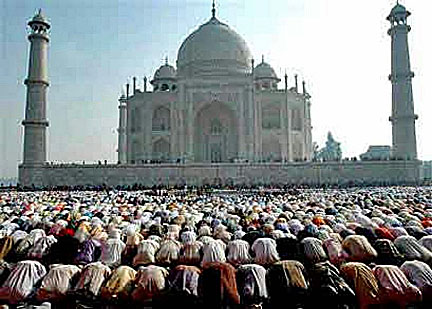
Muslims Praying
Islam
620-1400
AD
Basic
Reference on Islam
Rolf's Islamic
Art and Architecture

Muslims
Praying
Prophet Muhammad and the Qur'an
570-632 AD
Islam (“Submission” to God) is a rigorously monotheistic Abrahamic religion articulated by the Qur'an - a book considered by its adherents to be the verbatim word of God (Allāh) - augmented by the teachings (Sunnah) and normative example (Hadith) of Muhammad, who is considered to be the last prophet of God. Muslims believe that the Qur'an was verbally revealed by God to Muhammad through the angel Gabriel (Jibril), gradually over a period of approximately 23 years, 609 AD to 632 AD. the year of his death. The Prophet was married to 11 women, but had only one surviving daughter, Fatimah from his first marriage (595-620) to Khadija.
The Qur'an teaches
that God is one and incomparable, and the purpose of man's existence
is to submit to and serve Allah (God). Muslims also believe that
Islam is the complete and universal version of a primordial faith
that was revealed before many times notably through Adam, Noah,
Abraham, Moses and Jesus, whom they consider prophets.
Muslims
believe that the creation of everything in the universe was brought
into being by God’s sheer command, “‘Be’ and so it is,” and
that the purpose of man's existence is to worship God. He is viewed
as a personal god who responds whenever a person in need or distress
calls him. There are no intermediaries, such as clergy, between
believer and God.
The Islamic holy books are the records which were dictated by God to
the Prophet. Parts of the previously revealed scriptures, the Tawrat
(Torah) and the Injil (Gospels), had become distorted—either
in interpretation, in text, or both. The Qur'an (literally, “Reading”
or “Recitation”) is viewed as the final revelation and literal
word of God and is widely regarded as the finest literary work in the
Arabic language. The Qur'an is divided into 114 suras,
or chapters, which combined, contain 6,236 āyāt, or verses
(Arabic-English parallel translations of
the verses). The chronologically earlier suras, revealed at
Mecca, are primarily concerned with ethical and spiritual topics. The
later Medinan suras discuss mostly social and moral issues relevant
to the Muslim community. The Shariʻah
("the path leading to the watering place"), Islamic Law is
based on traditional Islamic scholarship, which most Muslim groups
adhere to. Shariʻah "constitutes a system of duties and ancient
punishments that are incumbent upon a Muslim by virtue of his or her
religious belief".
Marriage
in Islam is a civil contract which consists of an offer and
acceptance between two qualified parties in the presence of two
witnesses. The groom is required to pay a bridal gift (mahr)
to the bride. Marrying more than one woman was practiced in Arab
culture before Islam arrived, therefore it is addressed in the Quran
(verse 4:3) limiting the number of wives to four and only if a man
could treat them with fairness and equity.
Another issue peculiar
to Islam is the concept of Jihad,
"to strive or struggle" (in the way of God). Jihad, in its
broadest sense, is "exerting one's utmost power, efforts,
endeavors, or ability in contending with an object of
disapprobation". Within Islamic jurisprudence, jihad is usually
taken to mean military exertion against
non-believers/non-Muslim/Muslim combatants who insulted Islam.The
ultimate purpose of military jihad is debated, both within the
Islamic community and without. Jihad is the only form of warfare
permissible in Islamic law and may be declared against illegal works,
terrorists, criminal groups, rebels, apostates, and leaders or states
who oppress Muslims. Most Muslims today interpret Jihad as only a
defensive form of warfare.
The proper recitation of the Quran is the subject of a separate
discipline named Tajwid,
which determines in detail how the Qur'an should be recited, how each
individual syllable is to be pronounced, where there should be a
pause, elisions, where the pronunciation should be long or short,
where letters should be sounded together, and where they should be
kept separate, etc.
The first fully attested complete translations
of the Qur'an into Persian appeared between the 10th and 12th
centuries. The Samanid king, Mansur I (961-976), ordered a group of
scholars from Khorasan to translate the Tafsir
al-Tabari into Persian. Later in the 11th century, one of the
students of Abu Mansur, Abdullah al-Ansari wrote a complete tafsir of
the Quran in Persian. In 12th century, Abu Hafas Najmuddin Umar
al-Nasafi translated the Quran into Persian. The manuscripts of all
three books have survived and have been published several times.
Brief History of Early
Islam
610-750 AD
During his time, Muhammad in Mecca preached to abandon polytheism and to worship one God. Although some converted to Islam, Muhammad and his followers were persecuted by the leading Meccan authorities. After 12 years of persecution by the Meccans Muhammad and his Muslim followers fled in the Hijra ("emigration") to the city of Medina (formerly known as Yathrib) in 622. There Muhammad established a political and religious state based on Islamic law. A Constitution was formulated, instituting a number of rights and responsibilities for the Muslim, Jewish, Christian and pagan communities of Medina, bringing them within the fold of one community — the Ummah.
The Constitution established Medina as a sacred place (barring all violence and weapons!). All the tribes signed an agreement to defend Medina from all external threats and to live in harmony amongst themselves. After two battles against Meccan forces by 629 Muhammad was victorious in the nearly bloodless Conquest of Mecca, and by the time of his death in 632 (at the age of 62) he united the tribes of Arabia into a single religious polity.
With Muhammad's death disagreement broke out over who would succeed him as leader of the Muslim community. Abu Bakr, a companion and close friend of Muhammad, was made the first caliph. His death in 634 resulted in the succession of Umar ibn al-Khattab as the caliph, followed by Uthman ibn al-Affan, Ali ibn Abi Talib and Hasan ibn Ali. The first caliphs are known as the Rashidun Caliphs (al-khulafā' ar-rāshidūn,"Rightly Guided Caliphs"), a bloody 30 years with three assassinations (632-661) followed by the Sunni-Shi'a Schism
Under the Rashidun, the territory under Muslim rule expanded deeply into the Persian Sassanid and Byzantine territories. When Umar was assassinated by Persians in 644, the election of Uthman as successor was met with increasing opposition. In 656, Uthman was also killed, and Ali ibn Abi Talib assumed the position of caliph. After the first civil war (the "First Fitna"), Ali ibn Abi Talib was assassinated by Kharijites in 661. Following this, Mu'awiyah seized power and founded the Umayyad Caliphates (661-750).
These disputes over religious and political leadership would give rise to a schism in the Muslim community. The majority accepted the legitimacy of the three rulers prior to Ali, and became known as Sunnis. A minority disagreed, and believed that Ali ibn Abi Talib was the only rightful successor; they became known as the Shi'a. After Mu'awiyah's death in 680, conflict over succession broke out again in a civil war known as the "Second Fitna".
The Umayyad dynasty (632-750) conquered the Maghreb, the Iberian Peninsula, Narbonnese Gaul and Sindh. Local populations of Jews and indigenous Christians often aided Muslims to take over their lands from the Byzantines and Persians Empires. Since the Constitution of Medina, Jews and Christians continued to use their own laws in the Islamic State and had their own judges. The descendants of Muhammad's uncle Abbas ibn Abd al-Muttalib rallied discontented non-Arab converts (mawali), poor Arabs, and some Shi'a against the Umayyads and overthrew them inaugurating the Abbasid dynasty (750-1258).
Sunni and Shia
661-present
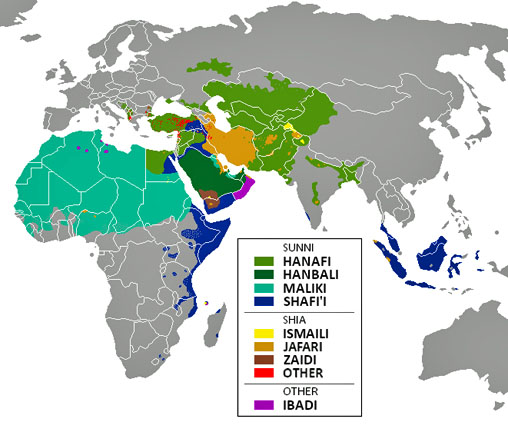
Distribution
of Sunni and Shia today
Shia Muslims today make up 10-20% of the Islamic population in the world. They are concentrated in Iran, Pakistan, India, Iraq, Azerbaijan, Yemen,and parts of Syria and Lebanon. As of October 2009, there were 1.571 billion Muslims, making Islam the second-largest religion in the world.
Aside from the lineage question, Shia theological beliefs and religious practices differ only slightly from the Sunnis', such as the number and timing of prayers. Shia Islam embodies a completely independent system of religious interpretations and political authority. The Shia believe that the status of Ali is supported by numerous hadith. They developed their own separate collection of hadiths. Shias regard Ali as the successor of Muhammad not only ruling over the community in justice, but also interpreting Islamic practices and its esoteric meaning. Hence he was regarded as being free from error and sin (ishma, infallibility).
In time the Shia developed several leading groups with their own political structure: Idrisids (788 to 985 CE) in Morocco; Uqaylids (990 to 1096) in northern Syria and Iraq; Buyids (934–1055) in Iraq and Iran; Ilkhanate (1256–1335) a Mongol khanate in Persia.
The Expansion of Islam
620-1400
AD
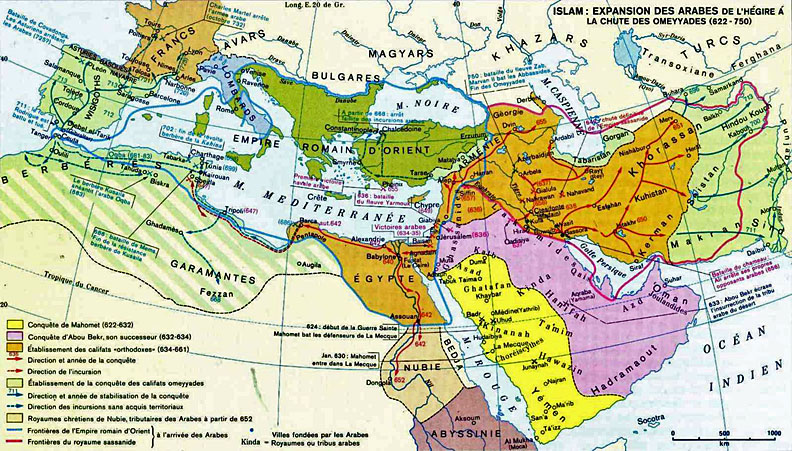
Expansion
of Islam 620-750 (coranix.fr)
enlarge
the map
The rapid expansion of Islam is a phenomenon that defies simple explantions. While Christianity took 600 years to transform Europe, within a mere 130 years Islam conquered the Near- and Middle-East from the Levant to the Indus, the crumbling remnants of the Eastern Roman and the Sassanid Empires, North Africa, and Sicily, and Visigoth Iberia. Its armies would have swallowed Western Europe had it not been for Charles Martell who defeated the Islamic advance forces at Tours in 732. Byzantine Constantinople, Trapezond, and Mytras were the last hold-outs until 1453-61. After the end of the Umayyads in 750 Islam had lost most of Spain to the Christian Reconquista, Sicily had been conquered by the Normans (1000-1200), but Greater Khorasan was solidly Moslem and Northern India had become the Sultane of Delhi (1220) under the Mamluks. And in 1453 Constantinople fell to the Turkish Ottomans. See the map below.
One of the historically most interesting and enjoyable documents of the 14th cent is ibn Battuta's “Rihla” (1325-1453). The opinionated adventures of a well educated Moroccan jurist along the frontiers of Islamic expansion, with four visits to Mecca, a mission to Andronikos II, the Byzantine Emperor at Constantinople, Khorasan, 8 years in Tulunid India, China, Andalucia, and Mali in Central West Afrca. - Compared to Marco Polo, he is a precise geographer and an astute observer of the social customs of his time. His descriptions of the women of the Maldives are priceless – he married one.....
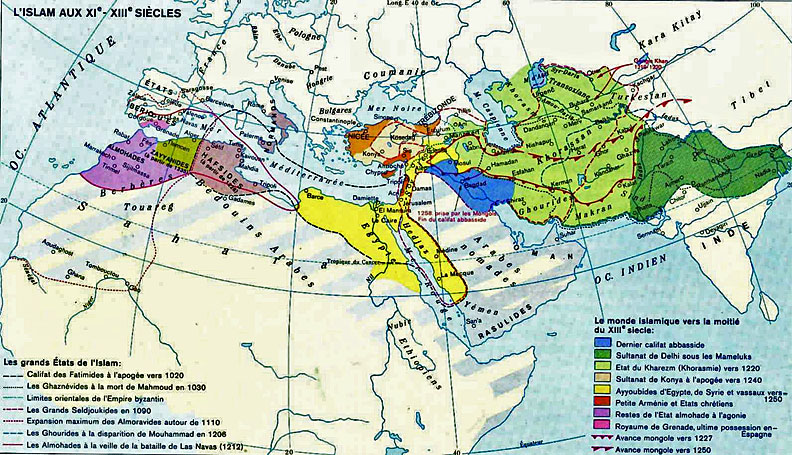
Expansion
of Islam 1000-1300 (coranix.fr)
enlarge
the map
Islam and its Architecture
The cultural bloom that Islam inspired in the newly acquired lands is best reflected in its architecture. Images of God, the Prophet, and humans being forbidden – except in miniatures – Islam spent all of its creative energies in reinventing the architecture of sacred spaces. One has to remember that this architecture is contemporaneous with the pre-Carolingian Romanesque style which eventually would profit from the Islamic examples. The Islamic service required a totally different space. Instead of the elongated Romanesque nave oriented towards an altar, it needed a 90-degree-turned floor plan of, e.g., the Christian St John's cathedral, to arrive at the Great Umayyad Mosque, facing an unadorned Mihrab in the long side-wall. Eventually Islam found its own space solution, as in the Mezquita of Cordoba, or the large domed structures of the Midle East.
More revolutionary were the Islamic approaches to the interior wall decoration of their mosques. In the Dome of the Rock Byzantine craftsmen installed mosaiques in which the saints were very successfully replaced with floral motives. In time (11-12th cent) these developed into sophisticated, totally abstract geometric patterns - “Arabesques”, which may cover whole walls, like in the Alhambra or in the Norman churches(!) in Sicily. The colorful domes of Sinan's mosques, the Safavid domes of Isfahan, and the Taj Mahal's marble intarsia are among the highest form of this art decorative.
The following photos are attempting to show the beauty of Islamic architecture, and simultaneously its spread geographically and in time.
Selective links provide information on the buildings and dynasties. - Click on the images most can be enlarged
Umayyad Levant, North Africa,
and Spain
7th-9th cent
|
|
|
|
The Dome of the Rock and the Umayyad mosque in Damascus are the two
earliest Islamic buildings. Built with the help of Byzantine
craftsmen – the Damascene Great Mosque enlarged a Christian Church
dedicated to Saint-John-the-Baptist, which initially Chistians and
Moslems had shared, to the needs of large, Mecca-oriented Islamic
prayer services (size and orientation of nave and courtyard). The
Baptist still has a chapel in the mosque.
Among numerous mosques
they built two superb ensembles, the Alhambra, the fortified palace
of last Arabic Kingdom in Granada, and the Mesquita in Cordoba. The
Mesquita
is probably the most spiritual, otherworldly sacred space ever
conceived. Its serenity surpasses Gothic churches and may only be
approached in different ways by the small vilage churches of the
Bavarian
Baroque in the 18th century. Holy Roman Emperor Charles V
(1516-1556) was so enamored with this space that he had a Renaissance
church inserted into the vast nave. He regretted it later – and
indeed one doesn't have to notice its profanity.
Umayyad Al-Andalus,
Spain
8th-14th cent
|
|
|
|
The Umayyad Empire, while a disaster for Christianity produced a miracle in Spain, Umayyad Al Andalus (755-1051), a polyglot Arabic-Jewish-Christian cultural symbiosis with a never again achieved Islamic-Mozarabic architecture and a florishing poetry, philosophy, and medicine. - This glorious “experiment” was finally destroyed by the brutal Christian Reconquista (711-1492) an the Inquisition of the Catholic monarchs Ferdinand and Isabella of Spain in 1492.
Umayyad Middle-East, North
Africa and Seljuk Turkey
7th–16th
cent
|
|
|
|
|
Ottoman Turkey, Mimar Sinan's
Architecture
16th cent
|
|
|
|
Mimar Sinan
(Joseph) (1489-1588) was the chief architect-engineer for three
Ottoman Sultans, Suleiman the Magnificent, Selim II, and Murad III.
He was born either an Armenian, Albanian, or Greek Christian. At the
age of 32 Sinan was conscripted into the Janissary
Corps and converted to Islam.
When Chelebi Lütfi Pasha became
Grand Vizier in 1539, he appointed Sinan, now 50, to the office of
"Architect of the Abode of Felicity"; the start of a
remarkable career. During his life time he built 135 mosques, 64
medrese, 22 mausoleums, 20 orphanages and hospitals, 7 aqueducts and
bridges, 48 caravansaries, 35 palaces, and 46 baths!
Sinan's
career can be illustrated by three major works: the Şehzade Mosque,
the Süleymaniye Mosque when he was 70, and the Selimye in Edirne,
his masterpiece at 85. He died 11 years later. He is buried adjacent
to Suleiman the Magnificent in the shadow of the Sülimaniye.
Timurid Samarkand,
Uzbekistan
17th cent
|
|
|
|
Samarkand - Alexander's Marakanda – after several destructions was rebuilt by Timur Tamerlane next to its ruins (Afrasiyab). The ruins of Marakanda have never been excavated, what we admire today is the 14th-17th cent capital of the Timurids (1370-1507) which later became Shaybanid/Uzbek (16th-17th cent) (Archnet). Samarkand's colorful decorative style, not surprisingly, influenced Islamic architecture throughout Central Asia.
Safawid Isfahan, Iran
17th
cent
|
|
|
|
The high point is, of course, Safavid Isfahan. In 1598 Safavid Shah
Abbas the Great moved the Persian capital from Qazvin to Isfahan.
This change ushered in a golden age for Isfahan which lasted until it
was sacked by Afghan invaders in 1722. Shah Abbas conceived of a plan
of rebuilding the center of his capital in grand style. He needed
arcihitects and experienced masons and artisans,which he found in
Armenia. Without much ado he imported 150 000 people from Ottoman
Djulfa near Nakhichevan
to New Julfa in Isfahan providing them with schools, churches and
privileges. Many descendants are still living there.
The Timurid
style of Herat (
Afghanistan), Abbas' birthplace, exerted a powerful influence on his
plan of Isfahan. In addition to a number of Mosques and the Royal
Palace surrounding Naghsh-e-Jahan Square, Abbas accomplished a superb
urban design. Even today, the city retains much of its past glory. It
is famous not only for its Islamic architecture but also for its many
beautiful boulevards, covered bridges, palaces, mosques, and
minarets.
Mughal India and Pakistan
16th-18th cent
|
|
|
During the last quarter of the 12th century, Muhammad of Ghor invaded Northern India, conquering in succession Ghazni, Multan, Sindh, Lahore, and Delhi. Qutb-ud-din Aybak, one of his generals proclaimed himself Sultan of Delhi and established the first dynasty of the Delhi Sultanate. The Tughluq dynasty (1320-1413) (see ibn-Battuta!) was the third Dehli Sultanate. The Sultanate ushered in a period of Indian cultural renaissance. The resulting "Indo-Islamic" fusion left lasting monuments in architecture, music, literature, and religion. In 1526 the Delhi Sultanate was absorbed by the emerging Mughal Empire (1526-1858)
The Taj Mahal mausoleum was built by Shah Jahan in memory of his favorite wife Arjumand Banu Begam, better known by her title Mumtaz Mahal (d.1631), from which the name of the monument derives. The pinnacle of classical Indo-Persian architecture, the Taj Mahal is representative of Shah Jahan's interest in architectural and aesthetic innovation. The new architectural style includes aspects that were to influence much of subsequent Indian architecture: Symmetry along two sides of a central axis, new columnar styles, curvilinear forms, and symbolic decorations based on naturalistic plant motifs are all characteristics of the Shahjahani style that can be found in the Taj Mahal Complex.
The Sufiya
660
AD-present
All
of Islamic art, especially calligraphy, miniature painting,
architectural
ornamentation is permeated by Sufism.
Sufism or
taṣawwuf is the name
for both the esoteric, inner mystical dimension of Islam and its
practitioners; a philosophy that pre-dates Islam, the expression of
which flowered within Islam. Its essence has also been expressed in
other religions (Daoism, Buddhism, Dzogchen, Ch'an) and metareligious
practices. A practitioner of this tradition is generally known as a
ṣūfī. Sufis consider themselves to be the original true
proponents of the pure original form of Islam.
They belong to
different ṭuruq or "orders"—congregations formed around
a master—which meet for spiritual sessions (majalis, semas), in
meeting places known as zawiyahs, khanqahs, or tekkes. Sufi turuq
(orders) or tariqua (path) most trace their original precepts from
Prophet Muhammad through his cousin and son-in-law Ali ibn Abi Talib,
(Shi'a lineage), with the notable exception of the Naqshbandi
who trace their origins through the first Caliph, Abu Bakr (Sunni
lineage). Prominent orders include Ba 'Alawiyya, Chishti, Rifa'i,
Khalwati, Mevlevi, Naqshbandi, Nimatullahi, Oveyssi, Qadiria
Boutshishia, Qadiriyyah, Qalandariyya, Sarwari Qadiri, Shadhiliyya
and Suhrawardiyya. Sufism is opposed by the conservative Wahhabi
and Salafist Muslims.
Classical Sufis were characterised by their attachment to dhikr, (a practice of repeating the names of God, often performed after prayers) and asceticism. Sufism gained adherents among a number of Muslims as a reaction against the worldliness of the early Umayyad Caliphate (661–750 AD). Sufis have spanned several continents and cultures over a millennium, originally expressing their beliefs in Arabic, before spreading into Persian, Turkish, Indian and a dozen other languages.
One of the best-know orders are the Turkish Mevlevi.
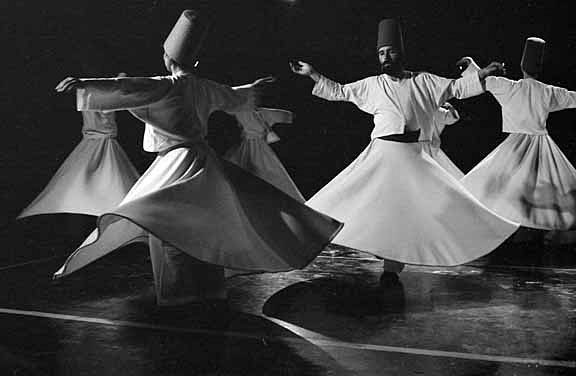
An
American Mevlevi group dancing a sema in Los Angeles, photo RWFG,
1981
The Mawlaw'īyya / Mevlevi Order is a Sufi order founded in Konya (then the capital of the Anatolian Seljuk Sultanate) in 1273 by the followers of Jalal ad-Din Muhammad Balkhi-Rumi, a 13th-century Persian poet, Islamic jurist, and theologian. They are also known as the “Whirling Dervishes” due to their practice of whirling as a form of dhikr. The whirling is part of the formal ceremony of their "sema". Since Atatürk's edict abolishing all Sufi orders in Turkey (1925) they have gone underground and spread all over the West. In Istanbul they preform in son-e-lumiare performances for tourists at a “Dervish Museum” (UNECO)